
DIVING IN THE MOON
HONORING STORY, FACILITATING HEALING
©Srebrenka Peregrin and Erika Katačić Kožić
The storytelling scene in Croatia is still in its fledgling state, but thanks to several dedicated storytellers scattered throughout the country, it is slowly starting to spread its wings. The two of us met at a local storytelling event in 2014, and since then we have had the honor and pleasure of contributing to this revival as a team. One of the most important projects we have worked on together is the Strong Women Project, a storytelling and crafts series started in 2016.
Vestigium
The project began in cooperation with Vestigium NGO in Croatia’s capital, Zagreb. Vestigium is an effort of love dedicated to bettering the life of the community in Vrbani, one of Zagreb’s newest neighborhoods. This neighborhood formed towards the outskirts where cornfields once stretched and is one of the city’s few that lacks a farmer’s market, library, health care center and community center, leaving many young families without a
healthy alternative for their free time.
Thus in 2013, Irena Borovina together with a group of her friends founded Vestigium Association with the purpose of providing a place for locals to gather and engage in activities that promote healthy living in a creative way, and to promote a humane, healthy and natural lifestyle in the community. The association’s president is Irena Borovina, and all projects and activities are non-profit and run by volunteers. Most funding is obtained
via local and regional administrations, national funding, funding by other trusts and institutions, corporate and private donations, and membership fees. The association’s most significant project is the ecological farmers’ market in which local producers come to sell their organic produce and products in Vestigium. The farmers’ market is held twice a week and also serves as a place for all members of the community to gather and socialize. At least once a month during the farmers’ market, a story hour is held for children. The story hour is led by Erika (storyteller) and Daša Filipčić (creative crafts leader). It started out as a literacy awareness project for children and quickly grew into a larger project that includes a free library and numerous story-related programs for all age groups.
How Strong Women Were Born
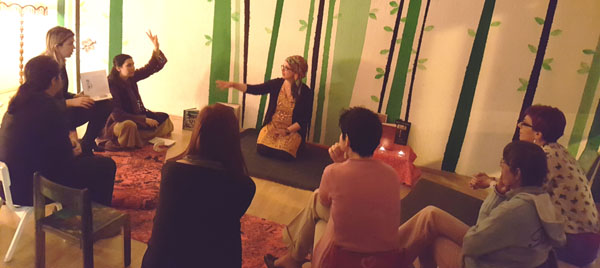 The Strong Women Project began as part of this larger project aimed to offer the local community a place to build ties through promoting book sharing, literacy, and reading. It was led by Srebrenka and Erika (storytellers) and Daša (creative crafts). The idea for the project’s focus came from last year’s World Storytelling Day theme, which was Strong Women. We decided to elaborate on the stories that strengthened women in the community since they are primary caretakers in households and our most common guests at storytelling gatherings.
The Strong Women Project began as part of this larger project aimed to offer the local community a place to build ties through promoting book sharing, literacy, and reading. It was led by Srebrenka and Erika (storytellers) and Daša (creative crafts). The idea for the project’s focus came from last year’s World Storytelling Day theme, which was Strong Women. We decided to elaborate on the stories that strengthened women in the community since they are primary caretakers in households and our most common guests at storytelling gatherings.
We wanted to create a safe place where women could enjoy a cup of tea, listen to stories that spoke of their power, and also share their own. The sessions were designed in a manner to encourage but not force participation. Thus we sat in a circle and shared stories. After each story, we would encourage discussions and ask if anyone would like to share an anecdote, a memory or even a whole story of their own.
Our hope was that by having a safe place to practice story sharing and presentation, the women would take this experience back to their homes and share some of the stories with their children, families, and friends.
Along with the narrative part, we also had a creative part to the sessions, so that women could shape into a tangible form the thoughts or inspirations they had while listening to or telling stories. It was also a lovely way for guests and storytellers to socialize, talk, and learn new crafts.
The project in 2016 consisted of five sessions, four of which we held at Vestigium and one at a safe house for victims of domestic violence. Some forty women and ten children were included altogether, and a diverse wealth of folk and fairy tales, biographies, autobiographical stories and authored works were shared.
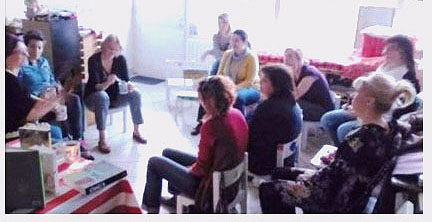
The Four Evening Sessions
Our first storytelling evening was held in April with the title “Fairy Tales and Biographies”. We told stories of both imaginary and real-life heroines who have inspired us to live better lives. The three inspirational
women mentioned that evening were the therapeutic storyteller Susan Perrow, the eclectic singer and songwriter Amanda Palmer, and the ancient Egyptian Queen Hatshepsut, a female pharaoh of the Eighteenth Dynasty. Connected to the latter, we told the story of Rhodopis, one of the oldest known variants of Cinderella. In this story, an eagle brings the red shoe to a prince. Another story shared was the retelling of Clarissa Pinkola Estes’ rendition of Andersen’s Red Shoes, since this story holds a special meaning to Srebrenka, just as the Ayaymama legend was told for its personal importance to Erika. In this Amazonian legend, two children are abandoned in the jungle, much like Hansel and Gretel, but instead of meeting a witch, they are transformed into little birds which, to this day, fly among the trees lamenting their fate.
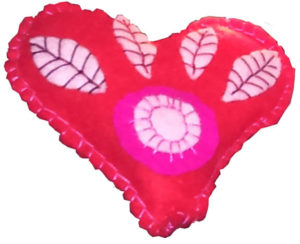 Erika also shared her authored work, The Little Elephant, which is a therapeutic story for children who find their tasks difficult or daunting. In this story, a little elephant is too tired to walk with the rest of the herd, until a little bird helps him by making special shoes that protect his feet. She often tells it to the accompaniment of digeridoo, miming the baby elephant’s and birds’ hoots. In the end, we made bookmarks with inspirational quotes, which we then shared with each other.
Erika also shared her authored work, The Little Elephant, which is a therapeutic story for children who find their tasks difficult or daunting. In this story, a little elephant is too tired to walk with the rest of the herd, until a little bird helps him by making special shoes that protect his feet. She often tells it to the accompaniment of digeridoo, miming the baby elephant’s and birds’ hoots. In the end, we made bookmarks with inspirational quotes, which we then shared with each other.
The topic for the second evening, held in May, came from participants themselves, so we talked about “Courageous Ones” – women who have distinguished themselves by their extraordinary bravery. The creative part was dedicated to sewing felt hearts, to remind us to have courage (from French cœur – heart) in our day to day lives.
Of the five stories told, one was about a famous Croatian heroine, Jelena Zrinska (Ilona Zrinyi) who struggled for national liberation against the Austrian Habsburg dynasty. She was also able to defend her castle against the Ottoman armies for three years before she was overcome and sent into exile.
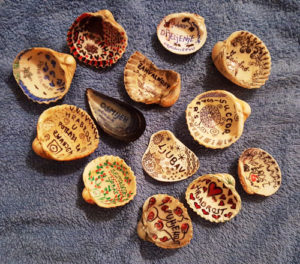 A visiting storyteller read her work about a fairy and St. Francis, which was written to help the author deal with separation from her daughter during the daughter’s college year spent abroad. We also heard the story of a famous Muslim mystic, Rabia, retold from a book by Arif Ključarić. Two stories were told from the HSA webpage as well – one was Srebrenka’s own story, A Hungry Princess¹, and the other was an Irish fairy tale, The Stolen Child, based on the version by Joan Stockbridge².
A visiting storyteller read her work about a fairy and St. Francis, which was written to help the author deal with separation from her daughter during the daughter’s college year spent abroad. We also heard the story of a famous Muslim mystic, Rabia, retold from a book by Arif Ključarić. Two stories were told from the HSA webpage as well – one was Srebrenka’s own story, A Hungry Princess¹, and the other was an Irish fairy tale, The Stolen Child, based on the version by Joan Stockbridge².
The third session was titled “Eve’s Stories” and was held in September. That evening we told stories of women who embarked on quests for knowledge, as well as stories of forbidden fruit and snakes. Afterwards, since the first story told was a Zulu legend about how stories were given to mankind through a sea shell, we painted shells with words that carry great importance for each of us.
The stories we told in these sessions were oftentimes found through intensive internet searches of credible websites and Erika’s rendition of the Zulu legend was based on the version provided in this link: http://www.canteach.ca/elementary/africa2.html
The fourth and final evening at Vestigium was dedicated to “Women in a Man’s World”. During this session in November, we talked about the different ways in which women – both historical and fictitious figures – deal with living in a world that seems to be much better suited to men.
From historical figures, we learned about one of the first female physicians, the Greek Hypatia of Alexandria, who had to practice along with her father, so that many of her works have been attributed to him. There was also the true story of Margherita Sarfatti, one of the most prominent propagandists for the Italian fascists in World War Two, as well as Mussolini’s mistress and biographer.
 As far as stories go, we listened to the story of the Princess Knight, Fet-Fruners. In this story, a woman disguised herself into a man and was finally turned into one in the course of her many adventures. Another story was that of Melusine, an important female spirit of water and a great builder in the French tradition. Found by a source deep in the forest, she wed Count Roland under the condition he never interfere with her time alone on Saturdays. However, as their children were born with curious features, he went against is promise. When he saw that she was half-woman half-dragon, she turned into a dragon and flew away, never to build towns or cities again. She would return later only to warn of death.
As far as stories go, we listened to the story of the Princess Knight, Fet-Fruners. In this story, a woman disguised herself into a man and was finally turned into one in the course of her many adventures. Another story was that of Melusine, an important female spirit of water and a great builder in the French tradition. Found by a source deep in the forest, she wed Count Roland under the condition he never interfere with her time alone on Saturdays. However, as their children were born with curious features, he went against is promise. When he saw that she was half-woman half-dragon, she turned into a dragon and flew away, never to build towns or cities again. She would return later only to warn of death.
We also created shapes with a quilling technique which served as a reminder to ourselves that women may from afar appear to be soft as paper, but contain an inner strength that can prevail and withstand the greatest of pressure and stress from the outside, just as paper properly folded will not bend even if stepped on!
The safe house experience
By far, the most challenging part was visiting the safe house to tell stories to women and children who have undergone violence and abuse. Will not stories sound frivolous in the face of such suffering? Won’t it be an invitation to escape from reality to some fantasy world? Could we even add to their problems by choosing the wrong stories? The answer, it turned out, is always – no.
Fairy tales can comfort listeners by showing how there are other people suffering as well, and that a way to victory or peace can always be found. Such stories are not an escape, but a balm to ease the acceptance of things that happened in order to be able to leave these painful events behind and journey forward into a new chapter in life. And, when stories are chosen with care, even if they sometimes sting, they never hurt. Children at the safe house ranged from ages 2 to 12, and they were all immersed in the storytelling. They joined us for refrains, and even danced in the end, when we told the story of Tipingi (based on Kathleen Ragan’s rendition).3 In this story, an entire village gathered to help the young hero fight a potential abuser. For the crafts part of the session, we made simple bear toys based on mamma bear taking care of her cub.
Feedback
We have asked the participants for their comments and these have been overwhelmingly positive:
“The Strong Women workshops offer exactly what a women’s circle should – warm beverages, a pleasant atmosphere, inspiring stories and something to keep our hands busy. For a few hours, I can get away from everyday life and relax in good company,” said Tilia.
Ivana wrote us, “I prepare, in spirit, for the women I will meet and for the stories, though the stories can never be predicted. I think about what to bring them, what gift to give to all of us. I know I will hear stories that will deeply affect me while enjoying the mellow light, the books, the warm tea, and the storytellers’ voices. (When I tell), I sit on the magic chair and become that voice. The women I meet are wise, warm, and full of
knowledge and virtues. Strong Women evenings are a place where I can be a woman in a different way; a place where I feel feminine energy pulsating through the stories. It makes me stronger, happier, and fills me with a positive expectation.”
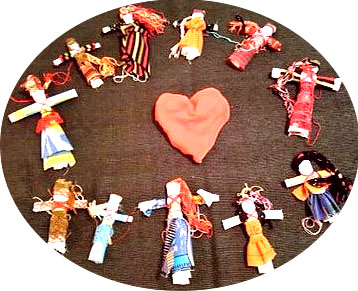 “I first came to the workshops out of sheer curiosity – because there was nothing similar organized anywhere. I am very interested in fairy tales and storytelling and believe they are important not only for children but
“I first came to the workshops out of sheer curiosity – because there was nothing similar organized anywhere. I am very interested in fairy tales and storytelling and believe they are important not only for children but
adults as well. The atmosphere is always friendly and jolly (with lots of tea, cookies, and laughter) so that everyone feels welcome and women even share personal stories about themselves and their families. The crafts at the end are a welcomed bridge between the world of fantasy and something more realistic and palpable and also carry a deeper meaning. Although I am not the most skillful person, I now have an assortment of wonderful memories that always bring a smile to my face,” was the comment from Anita, a regular at our storytelling evenings.
Katarina said, “Through the workshop, I have obtained wonderful gifts. To be able to strive in the atmosphere of acceptance is one of the most beautiful things one can enjoy, and this kind of understanding and learning is so easily achieved through Srebrenka’s and Erika’s storytelling workshops. This process is not only interesting and fun: It is also illuminating and it invites you to open up and share – and, in the end, have all the answers and support you need.”
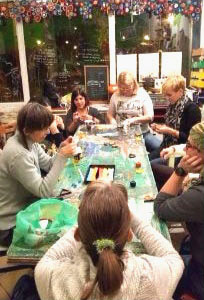 “I participated at a storytelling evening in September 2016. The event consisted of several stories originating from various parts of the world with a focus on women’s pursuit of knowledge and wisdom in the past and present. I thoroughly enjoyed being immersed in the archetypal and mythic background of the women seeking knowledge in the stories. The atmosphere of the event was supportive and inspiring, therapeutically positioned as a (women’s) circle in which all partaking were welcomed and motivated to share their visions, feelings, and thoughts, and contribute to the mutual formation of the healing ‘inner circle,’” Alina wrote. In Daša’s words, “It is wonderful to see and feel the energy of the women’s circle during storytelling, which creates a magical atmosphere that takes me to another world – a world of stories where everything is possible. During the crafts part, women pour their own experience of stories into their creations. The energy of listening turns into the energy of creating. I am thrilled to be a part of this circle.”
“I participated at a storytelling evening in September 2016. The event consisted of several stories originating from various parts of the world with a focus on women’s pursuit of knowledge and wisdom in the past and present. I thoroughly enjoyed being immersed in the archetypal and mythic background of the women seeking knowledge in the stories. The atmosphere of the event was supportive and inspiring, therapeutically positioned as a (women’s) circle in which all partaking were welcomed and motivated to share their visions, feelings, and thoughts, and contribute to the mutual formation of the healing ‘inner circle,’” Alina wrote. In Daša’s words, “It is wonderful to see and feel the energy of the women’s circle during storytelling, which creates a magical atmosphere that takes me to another world – a world of stories where everything is possible. During the crafts part, women pour their own experience of stories into their creations. The energy of listening turns into the energy of creating. I am thrilled to be a part of this circle.”
And this is how Maja, who has been our great support from the very first storytelling evening, rounds up the quotes, “The atmosphere is relaxed and stories inspiring. Days later, I still think about the stories and discover new details. The creative workshops remind me of tradition and carry the scent of bygone days.”
And they lived happily ever after
Come December, we wrapped up the project, hoping the approaching winter holidays would be a time when all our guests could tell more stories to each other in their own homes and personal gatherings. The positive feedback has been encouraging, and after many inquiries from participants and others that heard about our project but haven’t yet attended, we decided to continue with a new series of Strong Women in 2017. If financial support is attained, we plan to expand our project to reach out to at-risk and marginal groups in our community, or even beyond.
The Strong Women Project gathered women in a circle that gave them positive and hopeful narratives to incorporate into their daily lives. It brought women from the community together for evenings of warm companionship and a supportive atmosphere, in which, perhaps, the seeds of some future storytellers have been sown.
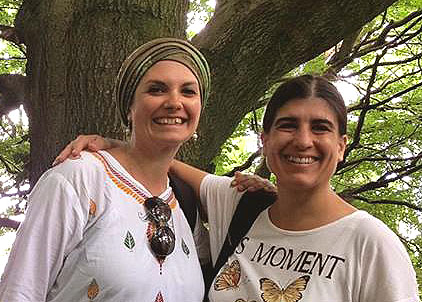 Srebrenka Peregrin is an EFL teacher by night and a storyteller by day. She promotes literacy in libraries and facilitates a circle of storytellers in Zagreb, Croatia. She has also been writing for a quarter of a century and has several of her stories published.
Srebrenka Peregrin is an EFL teacher by night and a storyteller by day. She promotes literacy in libraries and facilitates a circle of storytellers in Zagreb, Croatia. She has also been writing for a quarter of a century and has several of her stories published.
Erika Katačić Kožić is a chemist with a love for stories. In her free time, she tells authored works, folk and fairy tales, and is a published writer of children’s stories. She is co-founder and vice-president of The Fairytrail Association, a storytelling association in Croatia, and has been organizing storytelling events in Vestigium NGO since 2013.
Pripovijedanje is “Storytelling” in Croatian. If you are interested in receiving newsletters and updates about more storytelling activities from Erika and Srebrenka, they can both be reached at .
